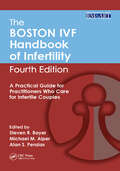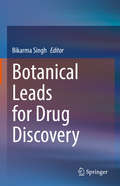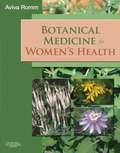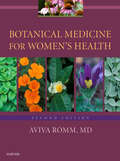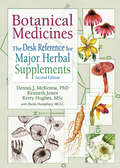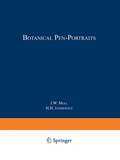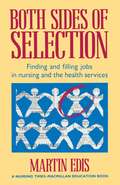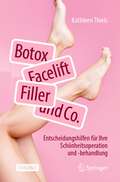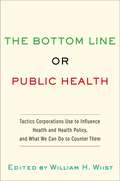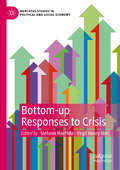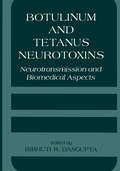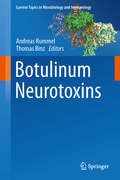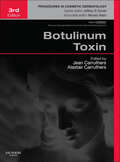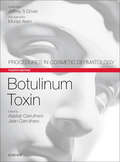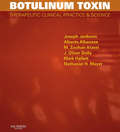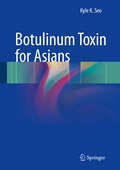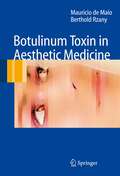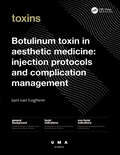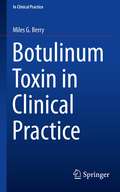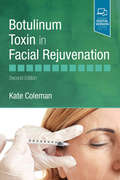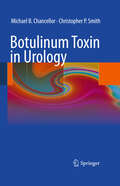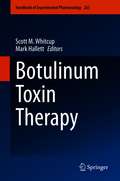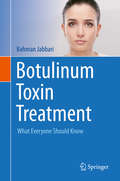- Table View
- List View
The Boston IVF Handbook of Infertility: A Practical Guide for Practitioners Who Care for Infertile Couples, Fourth Edition (Reproductive Medicine and Assisted Reproductive Techniques Series)
by Steven BayerBased on the gold standard procedures and protocols developed at Boston IVF, this new edition of a bestselling text continues to provide a structured approach to treating the infertile couple that can be of benefit to the gynecologist, reproductive endocrinologist, and reproductive medicine nurse alike. Both clinical and laboratory techniques are included, with material on preconception care. New to this edition are chapters on fertility care for the LGBT community, endometriosis, elective egg freezing, and effective nursing.
Botanical Leads for Drug Discovery
by Bikarma SinghActive botanical ingredients are a prime requirement for herbal formulations and discovering a drug is all about integration of science disciplines. In recent decades there has been a growing interest in treating wounds and diseases using traditional remedies based on local herbs, combined with chemical advances. Although this has led to the development of new bioactive ingredients from plants, there has been little success in terms of clinical trials and post-marketing studies to comply with FDA guidelines. Plants have been used as a source of medicine throughout history and continue to serve as the basis for many pharmaceuticals used today. However, despite the modern pharmaceutical industry being founded on botanical medicine, synthetic approaches to drug discovery have now become standard. Science-driven translational discovery and botanical development has created a new reality, leading to enormous changes in strategies, technologies and the disciplines involved, which have been embraced by the pharmaceutical and biotech industries. This book gathers scientific expertise and traditional knowledge to promote the discovery and development of new formulations and drugs based on active ingredients and to provide guidance on taking these to clinical trials. It discusses major topics, such as how the phytochemical composition of many plants has changed over time due to factors like cultivation, which can have both positive and negative effects on the levels of bioactive compounds. It also explores the importance of plants as a valuable source of therapeutic compounds as a result of their vast biosynthetic capacity, and classifies them according to their intended use, safety and regulatory status. Further, the book offers insights into the regulatory aspects of botanical products, which is an important issue when considering standardization and quality assessment, and also examines the commercial aspects of plant-derived medications and their proven role in the treatment of chronic diseases such as heart disease, high blood pressure, pain, asthma, and other associated conditions. Given its scope, this book is a valuable tool for botanists, natural product chemists, pharmacologists and microbiologists involved in the study of phytochemicals for drug discovery.
Botanical Medicine for Women's Health E-Book
by Aviva RommA comprehensive resource of medical and herbal interventions related to women's health issues, Botanical Medicine for Women’s Health provides a unique combination of traditional and modern scientific data on herbal medicine. Written by Aviva Romm, MD, an experienced herbalist, physician, and midwife, this guide blends a clinician-sensitive and patient-centered approach to women’s health issues. Coverage of menstrual health, fertility, breast conditions, and more makes this an essential resource for everyday practice. Winner of the 2010 American Botanical Council's James A. Duke Excellence in Botanical Literature Award!Expert author Dr. Aviva Romm combines her experience as an herbalist, physician, and midwife for a fully integrated approach to medical and botanical interventions.Convenient organization begins with herbal medicine and then covers health conditions organized chronologically by lifecycle help you understand the relationship between herbal medicine and women’s health. Plant profiles include principle uses, clinical indications, and safety information on the 10 most commonly used botanicals for women’s health. Detailed illustrations and professional plant photographs enable you to identify herbs visually as well as by substance make-up. Specialized focus on women’s health and botanical medicine provides the specific information you need for treating women at any stage of life. Content on over 150 botanicals for over 35 different conditions make this a comprehensive resource for current, evidence-based information. Appendices on common botanical names, quick dose reference charts, adverse interactions, and botanical medicine resources offer practical information at a glance. Over 30 expert contributors with a combination of practical experience as clinicians and teachers provide a unique, clinically based perspective on botanical medicine.
Botanical Medicine for Women's Health E-Book
by Aviva RommUse herbal medicines to treat women at any stage of life! Botanical Medicine for Women’s Health, 2nd Edition provides an evidence-based, patient-centered approach to botanical interventions for many different medical conditions. More than 150 natural products are covered, showing their benefits in gynecologic health, fertility and childbearing, and menopausal health. This edition includes new full-color photos of herbal plants along with a discussion of the role of botanicals in healthy aging. Written by Aviva Romm, an experienced herbalist, midwife, and physician, this unique guide is an essential resource for everyday practice of herbal medicine. Winner of the 2010 American Botanical Council's James A. Duke Excellence in Botanical Literature Award!Current, evidence-based information covers more than 150 botanicals for over 35 different conditions. Case studies provide realistic scenarios and help you apply the content to the real world. Treatment and formula boxes summarize the most important information.Color illustrations and photographs of plants enable you to identify herbs visually as well as by substance make-up. Logical chapter organization begins with the principles of herbal medicine and then covers women’s health conditions organized chronologically by lifecycle, from teen and reproductive years to midlife and mature years.Appendices include practical, at-a-glance information on common botanical names, chemical constituents of medicinal plants, and a summary table of herbs for women's health. NEW! Updates reflect the latest research and the most current information.NEW Full-color design and detailed, professional color photos of plants make this a unique, essential resource.NEW! Coverage of the role of botanicals in healthy aging for women features phytoestrogens, Ayurvedic/Chinese herbs, and discussions of health promotion.
Botanical Medicines: The Desk Reference for Major Herbal Supplements, Second Edition
by Dennis J Mckenna Kenneth Jones Kerry Hughes Virginia M TylerAnswer patients’questions about botanical supplements quickly and easily!This informative book is a compendium of detailed scientific research on 34 of the most popular dietary supplements used in North America and Europe. Its coverage of pharmacological studies on the main medicinal plants used in clinical practice and sold in pharmacies in the Western world is more extensive than any other publication of monographic reviews available. The way Botanical Medicines: The Desk Reference for Major Herbal Supplements, Second Edition. is organized (standardized topic formats are used in each monograph) makes it easy for you to locate relevant information quickly and to compare corresponding sections between different entries. This book is an invaluable tool for pharmacists, physicians, and other health care professionals who need detailed, scientifically accurate information on appropriate use, safety, dosages, and similar issues related to botanical dietary supplements.Each entry in Botanical Medicines: The Desk Reference for Major Herbal Supplements, Second Edition. covers botanical data (classification and nomenclature, common names, geographic occurrence, and botanical characteristics), plus: history and traditional uses chemistry therapeutic applications pre-clinical studies clinical studies recommended dosages safety profiles (including toxicology) side effects and contraindications drug interactions and special precautions safety recommendations during pregnancy and lactationThis extensively referenced volume includes appendixes with information on the major provisions of DSHEA (the Dietary Supplement Health and Education Act of 1994) and on the criteria and procedures for assessing the quality of botanical products.
Botanical Medicines: The Desk Reference for Major Herbal Supplements, Second Edition
by Dennis J Mckenna Kenneth Jones Kerry Hughes Virginia M TylerAnswer patients’questions about botanical supplements quickly and easily!This informative book is a compendium of detailed scientific research on 34 of the most popular dietary supplements used in North America and Europe. Its coverage of pharmacological studies on the main medicinal plants used in clinical practice and sold in pharmacies in the Western world is more extensive than any other publication of monographic reviews available. The way Botanical Medicines: The Desk Reference for Major Herbal Supplements, Second Edition. is organized (standardized topic formats are used in each monograph) makes it easy for you to locate relevant information quickly and to compare corresponding sections between different entries. This book is an invaluable tool for pharmacists, physicians, and other health care professionals who need detailed, scientifically accurate information on appropriate use, safety, dosages, and similar issues related to botanical dietary supplements.Each entry in Botanical Medicines: The Desk Reference for Major Herbal Supplements, Second Edition. covers botanical data (classification and nomenclature, common names, geographic occurrence, and botanical characteristics), plus: history and traditional uses chemistry therapeutic applications pre-clinical studies clinical studies recommended dosages safety profiles (including toxicology) side effects and contraindications drug interactions and special precautions safety recommendations during pregnancy and lactationThis extensively referenced volume includes appendixes with information on the major provisions of DSHEA (the Dietary Supplement Health and Education Act of 1994) and on the criteria and procedures for assessing the quality of botanical products.
Both Sides of Selection: Finding and filling jobs in nursing and the health services
by Martinis Martin EdisHealth services, one of the largest employers, are constantly in a bustle of change, with high staff turnover rates. This unique book is for you if you're either trying for a new job, promotion or a place on a course, or you're the one who's offering and selecting for it. All the procedures, techniques and hints for choosing or offering a position, making or analysing applications, being interviewed or interviewing, and reaching a final decision are given in comprehensive detail, with sensible and helpful advice.
Botox, Facelift, Filler und Co.: Entscheidungshilfen für Ihre Schönheitsoperation und -behandlung
by Kathleen ThielsDieser Ratgeber ist ein hilfreicher Begleiter auf dem Weg zu Ihrer inneren und äußeren Schönheit. Wenn Sie mehr über Schönheitsbehandlungen wissen wollen, ohne dass Ihnen jemand etwas verkaufen will und Ihnen eine realistische, neutrale Aufklärung wichtig ist, dann ist dieser Ratgeber richtig für Sie. Er gibt Antworten auf die Frage, warum wir auf der Suche nach der Schönheit sind und wie wir bei der Behandlungswahl nah bei uns bleiben können. Der Ratgeber klärt Fragen über Methoden, Nebenwirkungen und Heilungsablauf von ästhetischen Behandlungen wie z.B. Straffungsoperationen, Facelifting oder Botox und hilft Ihnen bei der Auswahl des richtigen Arztes. Außerdem beschreibt die Autorin alternative Methoden für ein positives Selbstbild. Das Buch ist von einer Fachärztin und Expertin auf dem Gebiet Plastische und Ästhetische Chirurgie geschrieben und wendet sich an Patienten, Angehörige und interessierte Laien.
The Bottom Line or Public Health: Tactics Corporations Use to Influence Health and Health Policy, and What We Can Do to Counter Them
by William H. WiistWhen corporations claim the same citizenship rights as human citizens, they exercise an undue influence on health policy and democratic processes. Surprisingly, the same basic repertoire of tactics has been found to be employed by corporations to effect this influence, regardless of the specific industry at work. In this book, authors from around the world reveal the range of tactics used across the corporate world that ultimately favor the bottom line over the greater good. The Bottom Line or Public Health deconstructs some of the most ubiquitous tactics at play, including public relations, political influence, legal maneuvering, and financial power, using the pharmaceutical, food and agriculture, tobacco, alcohol, and motor vehicle industries as illustration. However, there is a growing global movement to counter this corporate force. The book discusses the role of non-governmental organizations, indigenous peoples' groups, health advocates, and social justice activists, and the ways in which they are working to reduce corporate power and put control of policy back in the hands of individuals. The Bottom Line or Public Health is for scholars interested in studying the corporate entity, and for individuals and organizations who want to reclaim democracy for human citizens so that health is placed above the bottom line.
Bottom-up Responses to Crisis (Mercatus Studies in Political and Social Economy)
by Stefanie Haeffele Virgil Henry StorrCrises occur in all societies across world, and can be natural (such as hurricanes, flooding, and earthquakes), man-made (such as wars and economic downturns), or, often, a combination of both (such as famines, the flooding of New Orleans in 2005 after Hurricane Katrina and subsequent levy failures, and the earthquake, tsunami, and nuclear disaster in Japan in 2011). Crises cause fatalities, injuries, and property damages as well as introduce uncertainty and challenges for individuals, societies, and polities. Yet, we see individuals and communities rebounding effectively from crises all the time. How do communities go about returning to normalcy and beginning again the mundane life of every day affairs? This edited volume looks at bottom-up responses to crises. The chapters in this volume will highlight the ingenuity and persistence of individuals and private organizations as well as discuss the possibilities, limitations, and adaptability of bottom-up responses. It argues that there are many ways that local leaders, entrepreneurs, and community members can play a role in their own recovery by examining the capabilities, feedback mechanisms, and network effects of decentralized crisis response and recovery efforts. Chapters will focus on the role of local emergency managers in the disaster management process and offer suggestions for reform and the role of businesses, citizens, and children in providing crisis response and recovery. This book will also consider theories of self-governance and nonviolent action in encouraging and sustaining bottom-up recovery.
Botulinum and Tetanus Neurotoxins: Neurotransmission and Biomedical Aspects
by B. R. DasGuptaThree days in Madison have thoroughly modified my view on clostridial neurotoxins. While still realizing the numerous activating, modifying and protective inputs, I cannot judge the meaningfulness of the meeting impartially. Neither may the reader expect a complete summary of all presentations. Collected in this volume, they speak for themselves without requiring an arbiter. Instead I shall write down my very personal opinions as a researcher who has studied clostridial neurotoxins for nearly 25 years. Comparable conferences have been rare during this time. A comprehensive symposium 4 on C. botulinum neurotoxins has been organized at Ft. Detrick. International conferences on tetanus have been held regularly under the auspices of the Wodd Health Organization. One or maximally two days of these meetings have been devoted to tetanus toxin and its actions whereas the sponsor and the majority of the participants have been interested mainly in epidemiology, prevention and treatment of tetanus as a disease (see refs. 5,6). Some aspects of clostridial neurotoxins have been addressed in the context of bacterial toxins, in particular in the biennial European workshops. 1-3,7,8 The Madison meeting differed from the previous ones in three aspects. First, it covered both tetanus and botulinum neurotoxins. The fusion was justified because of their huge similarities in primary structure, in their mode of action and in their cellular targets. Second, the meeting was not limited to toxins but drew some lines on which modern neurobiology might proceed.
Botulinum Neurotoxins (Current Topics in Microbiology and Immunology #364)
by Andreas Rummel and Thomas BinzThe extremely potent substance botulinum neurotoxin (BoNT) has attracted much interest in diverse fields. Originally identified as cause for the rare but deadly disease botulism, military and terrorist intended to misuse this sophisticated molecule as biological weapon. This caused its classification as select agent category A by the Centers for Diseases Control and Prevention and the listing in the Biological and Toxin Weapons Convention. Later, the civilian use of BoNT as long acting peripheral muscle relaxant has turned this molecule into an indispensable pharmaceutical world wide with annual revenues >$1.5 billion. Also basic scientists value the botulinum neurotoxin as molecular tool for dissecting mechanisms of exocytosis. This book will cover the most recent molecular details of botulinum neurotoxin, its mechanism of action as well as its detection and application.
Botulinum Toxin E-Book: Procedures in Cosmetic Dermatology Series (Procedures in Cosmetic Dermatology)
by Alastair Carruthers Jean CarruthersThis title in the PROCEDURES IN COSMETIC DERMATOLOGY SERIES presents up-to-the-minute, practical guidance on botulinum toxin injection techniques shaping today's practice. Succinctly written and lavishly illustrated, it focuses on procedural how-to's and offers step-by-step advice on proper techniques, pitfalls, and tricks of the trade—so you can refine and hone your skills...and expand your surgical repertoire. You'll find current, to-the-point guidance on the cosmetic use of the toxin — edited by pioneers in the field, Drs. Jean and Alastair Carruthers. Implement the newest procedures into your practice immediately and confidently—with the outstanding guidance you'll find in this volume of the PROCEDURES IN COSMETIC DERMATOLOGY SERIES.Covers the hottest topics—including botox aesthetics, facial treatments, neck treatment, adjunctive treatment, pain relief, and facial asymmetry—all in one concise, accessible volume. Features a wealth of color illustrations and photographs that depict cases as they present in practice.Discusses common pitfalls and emphasizes how to optimize outcomes, enabling readers to improve their technique.Highlights emerging topics in the field, with guidance on the newest developments in cosmetic surgery.Includes a comprehensive, instructional DVD containing video clips of techniques and procedures as well as the experts' hints and tips.Use of fillers in combination with Botox to better sculpt the lower faceCoverage of new fillers like Juvederm, Evolence, Radiesse and Perlane to keep you on the cutting edgeNew and expanded coverage of periocular treatmentHighest quality video footage of procedures on the bonus DVD
Botulinum Toxin E-Book: Procedures in Cosmetic Dermatology Series (Procedures in Cosmetic Dermatology)
by Alastair Carruthers Jean CarruthersPart of the practical and dynamic Procedures in Cosmetic Dermatology Series, Botulinum Toxin, 4th Edition, brings physicians at all levels of experience up to speed with today’s best injection techniques. This well-organized text provides current, authoritative guidance on popular procedures including masseter hypertrophy and darker skin types, the therapeutic uses of botulinum toxins, and their future in dermatology. The renowned author team of Drs. Jean Carruthers and Alastair Carruthers offers evidence-based, procedural how-to's and step-by-step advice on proper techniques, pitfalls, and tricks of the trade, so you can successfully incorporate the latest procedures into your practice. Includes complete, clear descriptions and rationales for injection placement for facial and neck rejuvenation and hyperhidrosis, with high-quality videos demonstrating the techniques of injection. Addresses the differences in doses and particular characteristics among different botulinum toxin preparations in every chapter. Features a well-organized format with key points lists, pearls, and case studies as they appear in practice. Contains new chapters throughout, plus new information on injectable daxibotulinumtoxinA (RT002), topical botulinum toxin type A and benzyl alcohol. Includes many new images that depict exactly how to perform the techniques.
Botulinum Toxin E-Book: Therapeutic Clinical Practice and Science
by Joseph Jankovic Alberto Albanese M. Zouhair Atassi J. Oliver Dolly Mark Hallett Nathaniel H. MayerThe new, therapeutically-focused Botulinum Toxin presents comprehensive, cross-disciplinary guidance on current practices, covering more than 100 non-cosmetic conditions that occur in neurology, physical medicine and rehabilitation, pain medicine, ophthalmology, gastroenterology, urology, orthopedics, and surgery. International contributors review the current understanding of the biology and cellular mechanisms along with relevant research so you can easily apply them to the pathophysiology of the numerous disorders that botulinum toxin is used to treat—such as botulinum toxin applications for the treatment of cranial-cervical dystonias, motor disorders in cerebral palsy, bruxism and temporomandibular disorders, headache, overactive bladder, chronic pelvic pain syndromes, arthritis joint pain, and wound healing. With discussions of the latest in approved treatment practices as well as new and emerging uses, you’ll get in-depth management guidance on the application of the toxin.Provides clinical applications of botulinum toxin for over 100 disorders for immediate access and easy reference during practice and treatment. Covers a broad array of hot topics, including botulinum toxin applications for the treatment of cranial-cervical dystonias, motor disorders in cerebral palsy, bruxism and temporomandibular disorders, headache, overactive bladder, chronic pelvic pain syndromes, arthritis joint pain, and wound healing. Focuses on approved uses with expert advice on thoroughly tested applications but also discusses new and emerging applications to expose you to additional treatment options. Presents the most comprehensive and up-to-date material available so you get all the information you need from this one resource. Offers the cross-disciplinary guidance of the best world-class expertise through an authoritative, international group of authors who demonstrate the applications of botulinum toxin across various specialties.
Botulinum Toxin for Asians
by Kyle K SeoThis book, containing more than 400 photos and illustrations, provides practical guidelines for the cosmetic use of botulinum toxin type A (BTA) in Asians. The differences in BTA treatment of Asians and Caucasians with respect to applicable dose, injection methods, anatomic significance, and indications are clearly described. It is explained how the optimal dose and injection sites for the treatment of wrinkles differ from the guidelines advocated in North America and Europe. Detailed consideration is given to the rapidly expanding role that BTA treatment is playing in facial and body contouring based on leveraging the mechanism of disuse muscle atrophy. Examples that are particularly relevant in Asians include treatment of hypertrophy of the masseter and temporalis muscles and calf muscle reduction. Further chapters are devoted to the use of BTA in the treatment of hyperhidrosis and the intradermal injection of BTA. The book will be an excellent resource for all dermatologists, plastic surgeons, cosmetic Physicians, and other clinicians who employ BTA in Asian patients.
Botulinum Toxin in Aesthetic Medicine
by Mauricio de Maio Berthold RzanyWritten by two renowned experts, this book surveys the use of botulinum toxin A in aesthetic medicine, including patient selection and evaluation, as well as rules and requirements. The book provides hands-on information for common indications, such as forehead and glabella, lateral brow lift, crow’s feet and lower eyelid, bunny lines and marionette lines, nose and nasolabial folds, cheeks and "gummy smile," upper and lower lip, and the chin and neck. A section with tips and tricks makes this book an invaluable resource for the practicing dermatologist, plastic surgeons and all other physicians interested in the field of aesthetic medicine.
Botulinum Toxin in Aesthetic Medicine: Injection Protocols and Complication Management (UMA Academy Series in Aesthetic Medicine)
by Jani van LoghemBotulinum Toxin in Aesthetic Medicine: Injection Protocols and Complication Management This practical book is a quick review of the necessary details for safe and effective deployment of botulinum toxins in day-to-day practice, covering basic background information about the products, patient consultation, and treatment preparation, with more emphasis on injection patterns, relevant anatomy, and avoiding and treating complications. Offers a succinct but practical synopsis of treatment Presents a user's guide to the world's most popular aesthetic treatment Showcases the experience and viewpoint of a busy, dedicated aesthetic practice
Botulinum Toxin in Aesthetic Medicine: Injection Protocols and Complication Management (UMA Academy Series in Aesthetic Medicine)
by Jani van LoghemBotulinum Toxin in Aesthetic Medicine: Injection Protocols and Complication Management This practical book is a quick review of the necessary details for safe and effective deployment of botulinum toxins in day-to-day practice, covering basic background information about the products, patient consultation, and treatment preparation, with more emphasis on injection patterns, relevant anatomy, and avoiding and treating complications. Offers a succinct but practical synopsis of treatment Presents a user's guide to the world's most popular aesthetic treatment Showcases the experience and viewpoint of a busy, dedicated aesthetic practice
Botulinum Toxin in Clinical Practice (In Clinical Practice)
by Miles G. BerryThis book concisely summarizes the use of Botulinum neurotoxin in facial rejuvenation. It details relevant aspects of the physiology, pharmacology, safety profile and anatomy of the toxin. Chapters breakdown critical aspects related to the clinical assessment and aesthetic administration of this neurotoxin along with insightful information on its regulation. Botulinum Toxin in Clinical Practice provides a practically focused introductory text to the cosmetic applications of this neurotoxin in aesthetic dermatology, making it an ideal resource for the trainee practitioner seeking a concise summary of the topic.
Botulinum Toxin in Facial Rejuvenation E-Book
by Kate ColemanNow thoroughly revised to reflect state-of-the-art advances in the field, Botulinum Toxin in Facial Rejuvenation, 2nd Edition, covers the entire range of the use of botulinum toxin for cosmetic purposes. Dr. Kate Coleman offers practical guidance for safe handling, selection and assessment of patients, potential complications and pitfalls, and aesthetic techniques, as well as comparative modalities and long-term management. This is an ideal resource for anyone who offers this sought-after procedure, including cosmetic surgeons, oculoplastic surgeons, dermatologists, physician’s assistants, and registered nurses.Features new, unique coverage of long-term management, picturing the same original patients 15 years later, as well as observations on how treatments should be adjusted as the patient gets older in order to respond to natural changes in bone density and underlying support structures. Presents new knowledge on neuromodulation and how treatment can be used to ‘retrain’ expressions to provide fewer frowns lines and better facial symmetry. Offers comparative information on other modalities such as laser and hyaluronic acid, as well as potential risk factors, so you can choose the best procedure for each patient. Discusses the various forms of botulinum toxin currently available on the market, with an emphasis on Botox, Xeomin, and Dysport. Uses full-color clinical photos of pre-, peri-, and post-operative results to illustrate nuances of techniques as well as the effectiveness of botulinum toxin on wrinkles and scars for the major facial areas. Provides current guidelines on treatment methods and best practices for reconstitution and storage. Discusses which patients may be at risk for adverse effects―or "worsening results"―and offers suitable alternatives.
Botulinum Toxin in Urology
by Michael B. Chancellor Christopher P. SmithBladder injection of onabotulinumtoxinA for the treatment of urinary incontinence due to neurogenic detrusor overactivity has recently been approved by regulatory agencies in several EU countries and by the FDA in the United States. This is the first book to focus on the practical application of botulinum toxin (BoNT) in the genitourinary tract. It covers in detail applications of BoNT in the bladder and the prostate and pelvic floor, with reviews of the latest clinical series and techniques in both adults and children. Appendices containing easy-to-read instructions for patients undergoing bladder and prostate BoNT injections are included, in addition to procedural guidelines for nursing staff. The book is written in a concise, clinically relevant style by two leading pioneers in the field, who were the first to undertake comprehensive basic research into the mechanisms underlying the efficacy and potential uses of BoNT within the lower urinary tract.
Botulinum Toxin Therapy (Handbook of Experimental Pharmacology #263)
by Scott M. Whitcup Mark HallettIn a rapidly progressing field, Botulinum Toxin Therapy provides both clinicians and basic researchers with the latest science on the structure and function of botulinum toxins and the use of these toxins to treat a wide variety of diseases. Part 1 of the book reviews the basic science of botulinum toxins including advances in our understanding of the molecular structure and mechanism of action of botulinum toxins. This section also discusses the manufacturing and formulation of botulinum toxins for clinical use and the development of novel therapeutic toxins for the future. Part 2 reviews the use of botulinum toxins in clinical practice. It discusses the clinical pharmacology of botulinum toxin drugs and their use in a wide variety of clinical conditions including headache, spasticity, pain, disorders of the genitourinary and gastrointestinal tract, strabismus, and medical aesthetics.
Botulinum Toxin Treatment: What Everyone Should Know
by Bahman JabbariVery few therapeutic agents in clinical medicine have found indication for so many clinical conditions, and in such a short time as did botulinum neurotoxins (Botox and others). Chronic migraine, bladder dysfunction , dystonia, hemifacial spasm , blepharospasm , drooling, excessive sweating and spasticity are all approved by FDA and many other indications are in the near horizon . The aesthetic/cosmetic use of Botox and other BoNTs already has a huge market worldwide. Stroke, Multiple sclerosis, Parkinson’s disease, Cerebral palsy as well as brain and spinal injury are among clinical conditions in which some of patients’ major symptoms can respond to botulinum toxin therapy Several books have been written on the subject of Botox and other neurotoxins for treatment of medical disorders ( including two books by Jabbari both published by Springer 2015 & 2017). However, despite the huge interest and enthusiasm of the public to learn more about Botox and other toxins, there is currently no book in the market on this subject which is specifically designed to inform and educate the public on botulinum toxin therapy. Botulinum Toxin Treatment explains and discusses in simple language the structure and function of botulinum toxin and other neurotoxins as well as the rational for its utility in different disease conditions. Safety, factors affecting efficacy and duration of action, as well as cost and insurance issues are also addressed.
